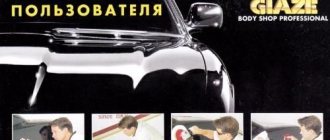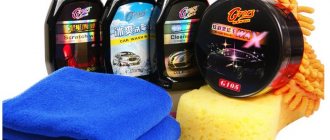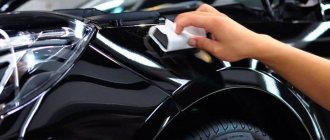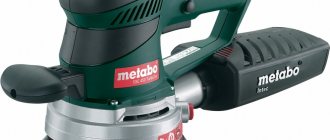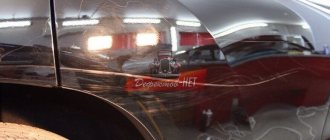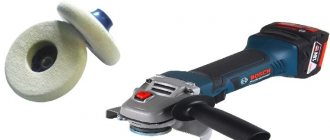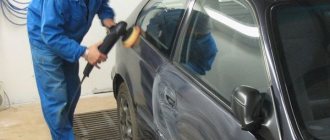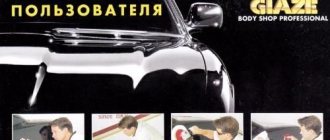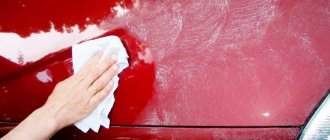If your car has scratches, the body has lost its former shine, and your mood has worsened due to the unkempt appearance of your vehicle - it’s time to polish it!
Many car enthusiasts solve this problem with the help of a car service, but we will tell you how to polish a car yourself. After all, once you invest in a polishing tool, you will save on the services of specialists. You will also need this knowledge when preparing your car for painting.
Where do circular scratches on the body come from?
You can often notice circular scratches on your car. They appear to be left by something that applied them in a circular motion. In fact, they appear circular in the sun or under artificial light because the sharp edges of the thin scratches catch and reflect light emitted outward in all directions from the central point of illumination. If you look at the same panel, but under diffuse lighting (not focused), you will find that thin scratches are located randomly in all directions and no longer look neatly round. That is, they look circular only under some kind of point (focused lighting, for example, under the rays of the sun), only the edges of the scratches around this illuminated center are visible.
Types of car body polishing
According to their intended purpose, polishing is divided into two types:
- restorative polishing of the car body;
- protective polishing of the car body.
Let's look at them in more detail.
Restorative polishing
Restorative polishing of a car is used to get rid of scuffs, oxidized layers, shallow scratches and small scratches (cobwebs), to restore color.
The depth of damage should not exceed the layer of primer paint.
Before starting restorative polishing, the following preparations should be carried out:
- wash the body;
- carry out degreasing, get rid of bitumen stains, organic and other contaminants;
- then drying and inspection for damage to the varnish surface;
- Cover chips and scratches “to the metal” with special tape;
- cover the headlights, rubber inserts, glass with tape;
- It is better to carry out polishing in a closed room without access to ultraviolet rays with good ventilation, since a large amount of dust appears during work.
It is carried out in two stages:
- Partial removal of paintwork using abrasive sandpaper - completely removes shallow small scratches;
- Polishing using an abrasive paste using a polishing machine with polishing wheels with varying degrees of fluffiness. A 5 µm surface layer is removed. The thickness of a good paint coating nowadays is 100-150 microns, so you can carry out 10 to 20 polishes without worrying about compromising its integrity.
You can do restorative polishing yourself. Check the thickness of the paint coating.
Protective car polishing
Unlike restorative polishing, protective polishing creates a layer on the surface of the body that protects it from harmful external factors. An important role in this process plays:
- correct application of the product;
- quality of the material used.
If these conditions are met, the polish layer will last a long time and extend the life of the paintwork.
There are two types of protective polishing:
- superficial – used for smoothing small damage;
- deep polishing – used to remove noticeable scratches.
When polishing, various protective car polishes are used.
FEATURES OF OUR POLISHING TECHNOLOGY
- Only significantly damaged areas are treated with high-performance abrasive pastes. This allows you to remove any scratches with the exception of the deepest damage “to the metal”.
- Using low-abrasive pastes, areas with minor damage are treated. This way we reduce paintwork losses several times.
- If the car is in good condition (only from the showroom), we can apply soft cleaning polishing methods without the use of abrasive pastes, achieving an ideal look without losing even a micron layer of paintwork.
Important rules for polishing
Not everyone knows for sure how to properly polish a scratch on a car. This is not the simplest procedure, which has its own nuances and rules. Based on important recommendations, you will definitely be able to competently approach the issue of polishing and get rid of noticeable scratches. Experts highlight these key rules.
- Selection of materials for body processing. The approach to purchasing must be extremely careful. Be sure to read the recommendations and instructions on the packaging, the composition and components included in the polish. Not all products cope with serious defects. But for the usual adding of shine, it is also strongly not recommended to buy abrasive compounds. Don’t be afraid to ask experts, ask for the opinions of motorists on thematic forums.
- Room. In order for the product to interact well with the body, you need to choose a dry and dark room with good ventilation. High-quality lighting also plays an important role, allowing you to see all existing damage, defects and scratches.
- Temperature. When you use sandpaper or a sander, the surface of the body heats up. Overheating can cause significant damage and destroy the paint layer. Therefore, it is recommended not to treat the same area for a long time.
- Body preparation. It consists in the need to remove all contaminants, dust, dirt and, of course, sand. Even a few grains of sand falling on the surface of the car during subsequent processing with a machine can create a large number of new damages instead of removing old scratches.
- Do not apply polishing pastes to abrasive wheels. This is especially true for products with large grains. Remember to constantly move around the body so as not to rub the same point for a long time, otherwise you will simply ruin the varnish.
- Never polish the body with gasoline or thinner. These are aggressive and potentially dangerous substances. Some claim that gasoline and solvent do an excellent job of polishing. But in reality, the paint layer from these products begins to quickly fade.
- Polish only from the top, moving towards the lower parts of the car body. Therefore, the roof comes first, and then to the hood, trunk, and the polishing of the wings and doors ends.
Based on these tips, never forget about the instructions of the manufacturers of polishing compounds. They will become the basis for body work. These same tips will be an addition and will help you better understand how and in what sequence you need to act.
How to polish a car body
The following polishes are available on the car market:
- liquid (more often used in the horizontal plane due to its fluidity);
- paste-like (universal, quite expensive, restore color saturation);
- aerosol (easy to apply, contain a low amount of polishing particles).
This entire list is suitable for both manual body polishing and when working with tools (drill and polishing machine).
Choose a method based on your assessment of the condition of your car’s body.
Caring car owners carry out preventive polish treatment at least once every four months. Minor defects can be easily removed before they become a serious “abscess on the body” of the car. Preparation of the body for such polishing is minimal, since serious paintwork defects rarely occur over such a short period.
In this case, the product is evenly applied to a soft, lint-free cloth (the aerosol is sprayed directly onto the surface). The polish on the rag should dry and turn white. The next step is to process the body itself, making circular movements with your hand. Continue working until a pronounced shine appears. Follow the instructions on the packaging, paying attention to:
- required amount when applied;
- drying time, etc.
Process technology
Polishing deep scratches is not a cheap pleasure.
You can do it yourself. But we must also take into account the labor intensity of the work, specifics and technology. First of all, you need to follow a number of rules. The car body and all its polished areas must be washed. Work is carried out in a clean, dry and ventilated area. Avoid exposure to direct rays of the sun. The polish will dry out quickly and the effect will not work. Lighting should be multipoint. During the work there will be a lot of dust, it will need to be removed. It is worth taking care of protective equipment - overalls, glasses. It will take a lot of strength and endurance. Before the process, dents should be leveled out. The scratches are too big; the chips need to be sealed with special tape. They need to be processed using a different method. Rubber and plastic parts (headlights) should also be sealed. With simple polishing, a layer of polish is applied to the surface without scratches, abrasions or defects. Deep polishing involves removing large scratches. First, abrasive polishing is carried out. Start with very fine sandpaper (p2000 or p2500). You will need a rubber block (to support the sandpaper) and water for wetting. Any significant scratch should be sanded down.
A large flaw is a flaw that can be felt with a finger. When the scratch goes away, you need to sand the area nearby using the finest sandpaper. At the end of this process, a uniform plane should form. To achieve a noticeable effect, it is advisable to make cross movements. It is better to mentally divide volumetric elements into sections and polish them in order. This manual labor can take up to 10 hours!
The next step will require a polishing machine. Before use, the surface requires moistening, and after applying polishing paste. The first pass is polishing at the lowest speed. This will allow the paste to be evenly distributed. Then the speed is increased. The car must be driven smoothly, slowly moving it from side to side. It is not recommended to stay in one place. It is better to return to the problem area later than to overheat it.
Manual processing of a car body: where to start?
First of all, you need to clean the surface of the body from dirt. This can be done by regular washing using a special shampoo. So let's get started:
- First, rinse the surface of the machine with cool water. Never wash your vehicle under the scorching rays of the sun, because... Rapidly evaporating water droplets can wear away your vehicle's paintwork.
- Pour some shampoo into a bucket of warm water.
- .When washing your car, start from the top of the car and as you wash off the dirt, work your way down, i.e. from the roof to the wheels. At any auto parts store you can purchase special wipes for car body care that will help you quickly and easily cope with the washing process.
- Leave the car for a while to allow the surface to dry on its own.
The vehicle washing stage is over, which means it’s time to move on to manual polishing . Microfiber cloths are best for the job. With their help, you will get a mirror-like shine to the paintwork and will not scratch the body. Squeeze a small amount of polishing paste onto the surface of the car body, rub it with light and smooth movements. As the napkin gets wet, change it for a new one. The process of polishing a car body will take about 2 hours.
Applying abrasive paste
We will not recommend you a specific manufacturer of polishes, because... There is already a fairly large range of products in this market segment. If you are pursuing the goal of restoring its former shine and giving your iron friend a feeling of cleanliness, choose restorative cleaners. If small cracks are visible on the paintwork of your car, choose wax polishes.
Sanding the paint surface of a car
If large cracks, scratches have formed on the body of your car, and paint has begun to crumble in some places, you need to prevent the formation of corrosion as soon as possible. To begin with, you will need sanding paper P1200-P1500 or a sanding machine for polishing a car for which you will use abrasive materials.
Here are a few guidelines to follow when sanding your car's paintwork:
- Start sanding only after thoroughly degreasing the car body.
- Use only clean abrasive material and clean water.
- Before starting work, soak the sanding paper in water with a little soap for 5-10 minutes.
- Use smooth, short strokes with the sanding paper to avoid large scratches.
- If you are using an eccentric sander, make sure that its grinding stroke does not exceed 3 mm.
- Wash any sanded material off the bodywork before polishing.
We return the car to its lost beauty
Applying a protective layer using a grinder
The next stage is polishing the car body. A forum dedicated to car body paint care clearly recommends operating the tool at a rotation speed of no higher than 2500 rpm. At a higher frequency, the body surface will become very hot. When buying a polishing machine in a store, pay attention to the smooth adjustment of the rotation speed at 500-2500 rpm.
So how to polish a car using this tool? First of all, you need to apply a small amount of polishing paste (10-20 grams) to a small area of the element. Next, you should put on a light orange polishing wheel, designed for rough polishing. Without turning on the tool, rub the paste over the surface to be treated. To avoid the paste drying out, it is recommended to polish surfaces with an area of 50 by 50 cm.
It's time to turn on the tool! Be careful and operate the polisher at low speeds. If the speed of the rough disc is too high, the paint surface may thin down to the bottom layer.
In order for the paste to be distributed evenly over the surface of the body, move the tool in a cross pattern, i.e. first horizontally, then vertically. Achieving the desired result is possible by repeating the “cross” two or more times with an increased speed of rotation of the circle.
After finishing polishing a specific element, it is necessary to remove excess paste from the surface of the body. The next section of the body is processed according to the same scheme. In general, the process of caring for paintwork takes about 8-10 hours, so you should be patient before the procedure, because polishing with a rough wheel is just the beginning!
As soon as you have carried out the initial polishing of the surface of the machine, you need to switch to a “softer” mode. Apply a small amount of polishing paste to a clean cotton cloth and carefully spread it over the car body. Don't be lazy and do the work carefully so that the polishing result lasts for a long time. After spreading the paste, wait until it begins to dry out. After this, turn on the machine with a circle intended for soft polishing, and repeat the previous recommendations for its implementation.
Finishing touch
Once all of the above steps have been completed, we move on to the last part of this difficult procedure - protecting the paint surface. The process of applying and distributing the protective polish is similar to the previous stage.
In order to maintain the shine, color and safety of the paintwork for a long time, renew the protective layer at least once a month.
To ensure that the work you do yourself does not differ from professional work, you must follow some tips:
- The polishing wheel should be clean and slightly damp.
- If the paste dries out too quickly, moisten the surface of the body with a small amount of water.
- To prevent car parts from overheating, do not polish the same area for too long.
- Apply the paste directly to the surface and not to the polishing wheel.
- While polishing, keep the tool parallel to the surface. This will allow you to avoid the formation of circular stains.
- It is necessary to start work at low rotation speeds, smoothly moving to higher speeds.
- When using pastes of different grain sizes, the surface must be thoroughly cleaned before applying.
- After each polishing step, thoroughly wash the wheels in warm water.
- After finishing polishing, it is recommended to wash the surface with soapy water.
How to properly hold the tool when polishing
Manual polishing of a car body - choosing a product
The composition is selected depending on the degree of damage to the paintwork.
Examine the paintwork and the metal underneath it in advance. If the problem is only loss of shine, the simplest composition will be enough. If a significant number of surface scratches are detected, two products will be needed - high abrasive and low abrasive. The first helps to effectively remove old varnish. Please note that to work with deep cracks you will need a special paste. When you use compounds with abrasive particles, be sure to cover the body with a protective layer. Otherwise, the vulnerable surface will quickly collapse.
Deep polishing of car body by hand
It is necessary to select the necessary tools and means.
If there are deep scratches, superficial “stroking” is not enough. Achieving a high-quality result will require more time, preparation and the procedure itself. Pay more attention to theory, for example, find a video with detailed instructions. To work you will need:
- polishing machine and wheels for it;
- “sandpaper” with grit P2000-25000;
- rubber scraper;
- clean, lint-free rags;
- pastes of varying degrees of abrasiveness (weak, medium, high);
- spray bottle and water.
Polishing the body with a machine with your own hands in this case begins with soaking sandpaper, cut into small pieces (this way you will achieve softness from the material). Then use this “sandpaper” to clean the damaged areas, removing any emerging dust with a scraper (use water to be more effective). Next, sprinkle the treated area with water and start working with a drill, placing a harder circle on it. Before turning on the device, apply an even layer of a highly abrasive compound to the contact part. At the end of the procedure, wash the car using a special shampoo.
Do-it-yourself car body polishing - nuances
Be patient and provide a comfortable working environment.
If you decide to act on your own, take care of yourself. The procedure takes a lot of time, so prepare a snack and drinking water, good music, fully charge the day before and take a power bank with you for comfort.
Contacting a car service will save time. You can find service stations on the aggregator Uremont.com.
Glass polishing
Car windows are constantly exposed to unfavorable materials, such as ordinary sand. Getting between the rubberized surface of the windshield wipers and the windshield, sand thins its top layer, causing unpleasant scratches. Polishing car glass is a relatively inexpensive procedure. The price for this type of work in a car service varies depending on the complexity of the work. Technologically, this process is no more complicated than conventional abrasive polishing, which means it can also be carried out independently.
In order for the polishing process to apply only to the glass surfaces of the car, it is necessary to cover the remaining elements of the vehicle with a protective film. Before moving on to the process itself, it is recommended to first wash the glass well and then outline the problem areas with a marker on the inside.
Be careful: if the glass has chips, do not start polishing. First, you should repair this area.
Polishing process
- Prepare a soft wheel for the polishing machine.
- Apply a small amount of polishing paste to the surface of the glass, distribute the entire mixture evenly over an area of 20 by 20 cm.
- Without turning on the tool, repeat the procedure to create a more even layer.
- Turning on the device at the lowest speed - 500 rpm - distribute the paste with light circular movements. Make sure that the pressure on the glass is not too strong.
- When polishing glass in a “cross” pattern, increase the speed gradually: first 1000 rpm, then 1500 rpm, etc. Having reached the 2500 rpm mark, move to the next section of the glass surface.
After a long and laborious polishing process, you need to remove excess paste with a soft cloth and then wash the glass thoroughly. In order not to stain the surface of the body, keep the protective film until the end of work.
The polishing process, of course, takes a lot of time and effort, but if you master the technique of professional car care for your car, you will be able to save money on car service services. Patience and self-confidence are the key to success!
Advantages of professional processing
You already know how to polish a car yourself. The procedure is not easy when it comes to restorative treatment. But many stubbornly continue to do everything on their own, ignoring the services of auto repair shops. Nowadays, it is not difficult to find instructions and tips on how to polish a body without outside help, using available tools and materials available in any store. But most of these methods involve gentle polishing, which is done using no more than 2 buffing wheels, one paste and a couple of finishing rags. You should not expect incredible results from such a procedure that will last for months. No one gives a guarantee of high-quality polishing. Only a few amateurs can achieve results similar to professional processing. And for this they will have to put in a lot of effort, time and nerves. If you choose professional polishing, you will receive the following benefits:
- Several polishing materials with different purposes and effectiveness are used at once;
- professional equipment is used during processing, which is extremely unprofitable to buy for personal use;
- Often at least 2 specialists are involved in polishing one car;
- polishing materials are selected based on many factors that can affect the final result;
- Experienced specialists work on the machine, which minimizes any errors and errors.
If you encounter fairly serious damage to the paint layer, it is better to entrust the work to trusted professionals. Each car owner decides for himself how and how often to care for his own vehicle. Some devote time to their car literally every week, others only wash their car occasionally, and can only dream of polishing their car. It’s not difficult to guess whose car will last longer and look much more attractive. The choice is yours.
Average cost of service:
- deep polishing – from 4800 to 10100 rubles,
- polishing one element – from 280 rubles,
- headlight polishing – 290 rub. for a unit.
The price of these works may vary depending on the prestige of the service station, the brand of the car and its size, urgency, and the type of materials used.
In addition to deep polishing, there is also soft, protective and restorative polishing.
Below is a video - a tutorial on polishing scratches with your own hands.
Why should you contact us?
If you are interested in reliable and effective protection of the car body from scratches and other damage, you can always use the services of our company.
- We employ only the most experienced and highly qualified specialists
- We use only the most modern polishing compounds and high-tech equipment to achieve good results.
- We have reasonable prices for work and consumables.
- We guarantee the quality and efficiency of fulfillment of each order.
You can always make an appointment for protective car polishing at our center by filling out the form on the website or calling us at +7 (495)-782-66-50!
Classification of scratches
It is customary to divide all encountered defects of this type into several varieties. There are scratches to the base, to the paint and to the varnish, and the latter are divided into ordinary and deep. And then there are also slippages. The last option is the most dangerous: there may be various defects to any degree. Rubbing in occurs when the body touches other cars, trees, branches, fences, etc.
Polishing is guaranteed to remove shallow defects from rubbing in, and at the same time restores the color. And more serious damage after it will be less noticeable. But this will not help the furrows down to the very base.
Scratches to base
By default it is metal, but in recent years, plastic has increasingly become the basis. In both cases, polishing will not help. Such furrows can be seen from afar, from any angle and even in low light. And in color, they differ from the body, the above-mentioned checks do not pass.
It must be said that scratches to the very base do not appear after washing or from a brush, even the hardest. Most often this is the result of vandalism: when someone deliberately damages the body with a nail or any other hard, sharp object. Also, deep grooves often appear during an accident, along with dents.
If you still try to polish, the defect will decrease slightly, but the result will be too weak for a meticulous inspection of the car owner. You'll have to go to the workshop and repaint the car.
Scratches to paint
They are also visible under water and can be caught with your fingernail. From scratches to the base, such defects differ only in color: they are less noticeable precisely because they do not differ in color from the body. The reason for the appearance is also often vandalism or an accident, careless parking. These defects are deep enough that a good master will not undertake to polish them in the first place. You can grease or mask it temporarily until the car is repainted.
Scratches on varnish
The majority are like this and I really want to polish them. Moreover, in both tests, ordinary scratches on varnish pass immediately: you can’t catch them with your fingernail, no matter how hard you try, and you won’t be able to see them under water either. This is where polishing really helps.
Unfortunately, there are many opportunities to again cause defects in this category to the body: rub the dirt with a sponge, wipe off the dust with a dirty rag, press hard on the napkin - and here they are. It gets ridiculous: passers-by in the parking lot touch the body with a bag or zipper - again, scratches.
Deep scratches in the varnish deserve special mention. This is approximately at the border of the paint and varnish layer. If you polish, you can remove the remaining varnish - and then you will have to repaint. Compounding the problem is the difficulty of assessing the depth of a scratch in a particular case. It feels like it barely clings to your fingernail, and is almost invisible under water, especially in low light. The price of a mistake is removed varnish, etc.
In practice, any scratches on the varnish are polished, provided that it is done professionally. For example, deep ones can be removed by sequentially using different sandpapers: from 1500 to 3000. By the way, keep in mind: sandpaper larger than 1500 is generally not suitable for polishing a body; it is a tool for carpentry work.
What is deep processing?
The procedure is carried out in several stages. First of all, remove the top layer of paintwork from the surface. If the scratches are too severe, the residual thickness is 5 microns. The treatment is carried out with a fine-grained sanding tape or disc.
Then the car body is deeply polished with abrasive pastes, for which special polishing machines are used.
At the final stage, the surface is treated with atnihologram paste.
The quality and cost of the service depends on the materials used.
What this processing will eliminate:
- cracks and scratches (up to 50 microns);
- stains, abrasions resulting from mechanical damage;
- damage to the paintwork from contact with other cars (including “foreign” paint);
- roughness of the varnish, noticeable to the touch;
- dust settled during painting.
Regular restorative polishing will help with some problems, but if the defect is serious, another treatment is necessary. Only experienced specialists can assess the extent of damage. Unfortunately, not everyone realizes this.
Which polish to choose
Depending on the nature and extent of the defects, a different list and complexity of restoration work is required. If you find it difficult to independently assess the condition of the body, it doesn’t matter, a specialist will carefully examine the damage and justify the need for work in each area.
You should definitely refuse offers from craftsmen to polish your car on their knees. For a complete and high-quality procedure, you need a special box with the ability to maintain a certain microclimate. To carry out effective deep polishing of a car body, it is necessary to identify defects in the paintwork, in particular, the depth of scratches, for which you need a thickness gauge.
Offers of “unique” services most often hide ordinary restoration work. Some do it poorly, others do it well.
6000 rub
- Complete car dry cleaning
8500 rub.
- Abrasive polishing with removal of scratches and application of a protective layer
9000 rub.
- Complete premium car cleaning
Choosing the optimal polish: opinions, ratings and reviews
With the current variety of products, it is difficult to choose a decent option at an adequate price. Low-quality materials can ruin all your work, so you should focus on the leaders. In the realm of polishing, two reign supreme: 3M and Farecla.
Each type of product has its own polishing wheel.
The first one is “tailored” for professionals. Due to the large packaging (from 1 kg), the starting price also increases (from 1,500 rubles for 1 type of polish). “Farekla” is more affordable in this regard - packaging from 250 grams at a price of 400 rubles. They are equal in quality. A small package is enough to polish a car twice. And if you consider that it is recommended to treat a car with factory varnish with abrasive paste no more than 5–7 times (this is with professional hands, no more than 3–4 for amateurs), then one kilogram will clearly be superfluous.
There are truly many varieties of Farecla brand products.
After assessing the condition of the body, you need to decide which fraction of abrasive to choose. There are:
- Large - 09374 from 3M or G3 from Farecla. Used for large scratches and pronounced dullness of the body;
- Small - 09375 or G6. Recommended for light dullness and a small number of small scratches, removes a smaller layer of varnish;
- The finish is code 09376 for 3M, and G10 for Farekl. The finishing paste eliminates the shortcomings of the first two and gives the paintwork a glossy shine.
Now he has released an improved version with a green cap and code - 50417. This polish is positioned as a universal polish and replaces the first two points.
Please note: manufacturers Koch and Menzerna are also popular in professional circles. They are more expensive and harder to find on sale, but the quality is at a high level.
Menzerna is a German professional polishing product that has been receiving the best reviews from users for several years now.
Without protection, the shine will not last long, so let’s move on to choosing the next type of polish.
Protective layer: how to choose good materials
There are even more varieties here and the price range is significant. Let's divide them by composition:
- wax is the most common, easy to use and cheapest type of protective polish. Almost every car wash has a waxing service;
- synthetic, which are divided into three more types: restorative - a weak replacement for abrasive polishes;
- silicone - quickly applied with a spray, but quickly washed off (an alternative to wax);
- polymer - full synthetics, which must be applied carefully and for a long time, but the protective properties last up to six months (a significant disadvantage is the price);
This is interesting: So is it possible to hide a number from the radar?
The most popular companies and reviews of their products
The table below shows the most popular brands for the production of protective polishes.
| Manufacturer | Country of origin | Price in rubles, from |
| Turtle Wax | USA | 200 |
| Sonax | Germany | 300 |
| Willson | Japan | 500 |
| Meguiars | USA | 600 |
| SAPFIRE | Russia | 150 |
| Hi-Gear | USA | 200 |
Hi-Gear "Restorer". The problem was that the color of the body had faded quite badly over many years of use and acquired various stains. I started with the hood. Traces of mosquitoes and flies were cleared quite easily with almost no effort. I had to work a little with the white stains from the previous polish, but I was pleased with the result; they were 100% gone. The color of the treated area was radically different in saturation and shine from the untreated areas. I gradually walked through the entire car, spending a total of two hours. As a result, oil and bitumen stains were completely removed from the body, and the color of the car turned out to be like new. Fuel leaks near the gas tank have been eliminated almost completely. The applied “Restorer” polish went through a hand wash perfectly, the color remained the same all summer. I recommend it to all owners of old cars and for pre-sale preparation, you don’t have to paint a car with minor defects in the paintwork.
ivan52
review_2154088.html
Turtle Wax Plus PTFE polish is expensive but effective. If you do everything wisely, then the polish is excellent, it gives shine and restores color, of course it doesn’t mask scratches, but in principle it copes with small scratches. The price of the polish is good, but it lasts for many times, I polished it three times and still have more than half of it left. The smell is pleasant, but a little cloying. In the morning after rain, the car immediately differs from its neighbors, since the drops still stick and do not “dry” into the body. Dirt doesn't stick to the car as much. Enough for two or three washes.
anufriev-pr
https://otzovik.com/review_2540156.html
The Sonax polish itself with the addition of a coloring pigment. That is, for a certain range of colors. In my case, metallic silver. It is visually quite difficult to distinguish the difference from “before” and “after” polishing with my color. But it is tactilely felt very strongly. The roughness of the surfaces has disappeared. Everything became smooth and glitters in the sun. Small cracks are sealed with a special pencil that comes with the kit. After which you need to go through the polish itself again. The pencil itself essentially clogs the crack under the polish with wax. Just a little thing goes off with a bang. Larger chips and scratches are of course to no avail. Well, it's not intended for them. Nevertheless, I am pleased with the result. Sonax justified its price.
Wicked-Safety
https://www.drive2.ru/l/6568971/
My husband doubted the quality of Sapfire car polish, because the price compared to others was completely ridiculous. But I decided to check it out anyway. The result was excellent. Sapfire car polish applies well, provides reliable body protection, adds shine and water-repellent properties.
sirena
https://otzovik.com/review_268445.html
I bought a special Willson cleaner to prepare the body for polishing, “Glass Body Cleaner,” and the polish itself for dark cars, “Body Glass Guard.” I washed the car 2 times, washed it early in the morning, while there was no scorching sun and the car was cold, I wiped and wiped everything again and began to apply the cleaner. It took me about 4 hours to wash, or even more, I got so carried away that I forgot about the time. After the entire process, the car must stand for at least 2 hours for the composition to set; you cannot wash it with chemicals for 7 days, the composition will completely crystallize during these days. What I noticed immediately was the shine, the difference is very visible. It was raining all this weekend - the drops on the car actually collected into larger ones and easily rolled off from the wind, when I drove out onto the highway from the dacha, the car instantly became dry, it was cool to watch how, when accelerating on the hood, one giant drop formed from small drops and easily flew away in a direction unknown to me) In short, I advise you, it really works!
grinngolder
https://www.drive2.ru/l/288230376152410795/
Good people from the car market advised me to buy a polish with wax from the American company Meguiar's. From the Internet, based on reviews and photos, I realized that a better polish has not yet been invented. In short, the result is obvious: the cobwebs are no longer so noticeable, the color is deep, the shine is mirror-like, drops bounce off when it rains, i.e. The moisture protection works and the body is therefore cleaner longer. You can even polish the headlights, the result is excellent. Polished with fiber without much effort. It remains to be seen how long this gloss will last. I'm happy with the result, the jar is large, the consumption is negligible, the price is good. In general, I recommend it!
stalkerr81
This is interesting: Driving a car with a CVT
https://www.drive2.ru/l/4169530/
Any of the presented materials deserved, according to survey participants in 2015, the maximum ratings in the rating. We will assume that you have decided on the materials for self-polishing. This means you can proceed directly to the process itself.
Removing shallow scratches
If your car has minor scratches, you can get by with a light abrasive polish. In a car service, they use a special tool for this, but buying it for one time is impractical. So, we will need:
- abrasive paste (it is better to use a fine abrasive);
- cloth napkin;
- wax polish.
The seller may offer you a paste with a pigment that will help polish out deeper scratches on the car. Here you don’t have to worry too much about the color of the pigment matching the car’s paint. In any case, the pigment will wash out after several washes.
How to remove minor scratches:
- First, you need to thoroughly wash the car body, let it dry and make sure that there is no dirt, sand or dust left on the car. Polishing must be done in a garage or outdoors, but only in calm weather.
- Now you need to apply a small amount of abrasive paste to a napkin and treat the damaged area in a circular motion with light pressure. Do not rub one place for too long - this can remove all the varnish in that area.
- The abrasive paste must be thoroughly rinsed off after finishing polishing.
- Then you need to apply wax polish to the damp surface, let the car dry a little, and then wipe the polished area dry with a clean soft cloth.
What scratches can be removed by polishing a car body?
Not all scratches that are present on the car body can be polished out. You can polish only those scratches that are within the varnish, but polishing deep scratches on the varnish is not advisable for the varnish itself.
Without damaging the paintwork, you can remove those scratches that do not catch with a fingernail; these scratches fall within the area of influence of standard polishing of the car body, as a result of which 4 microns are removed.
We recommend fusing deep scratches on the varnish (by heating the varnish as a result of polishing, remove the sharp edges of the scratch itself). In this case, the thickness of the varnish is maintained and the scratch becomes less noticeable; at some angles it will not be visible, but at some angles it will be visible.
Deep scratches down to paint or metal cannot be polished. If you have to put up with scratches that reach the paint, then with deep scratches that reach the metal, you can contact professional painting workshops, where these scratches can be removed without painting.
What else do you need to know about polishing?
Polishing the plastic of a car must be done with extreme care. The impact of high speeds on this material can cause overheating of its surface and, as a result, further deformation.
The car plastic surface to be polished must be damp , so do not allow the paste to dry on it. Failure to follow this recommendation will result in increased polish consumption and deep scratches.
Do you want to make your car powerful and beautiful? Then start with a body kit for your car yourself! Vinyl stickers will make even the oldest car live a new life. Read more about this invention in our article.
More fun on the road with music! How to make acoustics in your car, read the link.
Removing deep scratches
If the paintwork on the car has received significant damage, it will not be possible to get by with polish alone. The easiest way to remove such scratches on a car is to use markers. All you need to do is paint over the damaged area with a marker, and then polish it in the same way as with shallow scratches. This method is quite cheap and simple, but its effect is not long-term, so this operation will have to be repeated regularly.
The second method is do-it-yourself repair tinting. To carry out this operation you will need:
- base paint;
- varnish;
- primer;
- alcohol;
- thin brush with soft bristles;
- kit for removing shallow scratches.
Most modern cars are sold with a repair kit that includes base paint and clearcoat. If your machine did not come with a kit, then you need to select consumables.
How to remove deep scratches:
- The first step is to thoroughly wash the car and let it dry. The damaged area on the car should be treated with alcohol to completely degrease it. All work must be carried out in a dust-free environment.
- Then you should apply primer to the scratch and wait a little.
- Now you can start painting. You need to apply paint to the damaged area with a thin brush, being careful not to go beyond its boundaries. After this, you should let the paint dry. Drying time is indicated by the manufacturer on the packaging.
- The next step is to apply varnish. This process is carried out similarly to the previous one. Only the varnish must be applied beyond the boundaries of the damage and with a small margin, which will be erased during subsequent polishing. Now you just need to wait until the varnish dries, after which you can use the vehicle for its intended purpose.
- No earlier than a month after touch-up, it is necessary to polish the treated area on the car. To do this, use a paste with a fine abrasive and a wax polish. The process is no different from polishing shallow scratches.
After completing all of the above procedures, removing the scratch on your car can be considered complete. In some cases, it’s easy to do without a primer (if the scratches are not very deep), but it’s better to play it safe to avoid the paint shrinking during drying.
Do-it-yourself body polishing
If the owner of a car does not have time or a place where it can be repaired, then it is better to trust the specialists at the service station, who will quickly put the car in order.
However, here, as elsewhere, you will have to pay for the work. But protective polishing must be carried out regularly. This means that you will have to shell out a large sum annually to pay for the work of specialists.
The lowest price for polishing work is from 500 rubles, which is already a considerable amount.
Many drivers and car owners carry out this procedure on their own. As a result, costs are lower and the car looks like it came from a showroom.
It is better to carry out the polishing process in a warm, clean, well-lit garage, where the car is first washed and dried, without worrying about dust and various particles that may settle on the body during operation.
Note. You cannot polish a car in the air, as dust particles can scratch the body and you will have to contact a specialist.
The key to success in doing the work yourself is a clean place, surface preparation, a little patience, the availability of special tools, car cosmetics - and the result will delight you for months.
As in any business, dexterity and skill development are required here. Therefore, there is no need to be afraid, the skill will come after performing this type of work 3 times.
Helpful Tips:
- To prevent the cord from the polishing machine from getting in the way and accidentally scratching the paint, you can throw it over your shoulder.
- Do not polish in hot weather under direct sunlight. The polish will dry out quickly and will not work properly. In addition, a hot paint coating will heat up even more during polishing, which will have a bad effect on it. Also, you should not work in a dusty room. Dust or solid particles of dirt that fall on the panel will scratch the paint.
- There is no point in using too much paste and too high a rotation speed. Distribute it over the surface at the lowest speeds, and polish at medium speeds.
- For large volumes of work, it is important to periodically rinse the circle to remove excess paste.
- There is no need to pour a lot of water when polishing. Before starting, it is enough to spray it a couple of times from a spray bottle and then, if necessary, repeat this action.
- Particular attention and care must be taken when polishing ribs and sharp corners. In these places, the paintwork wears off very quickly.
- After finishing polishing, the remaining paste must be removed before it dries. Once it dries, this will be difficult to do. It is convenient to use a microfiber towel for this. If the paste gets into the gaps between the body and adjacent parts, you can sweep away its remains with a paint brush.
Sources:
https://kuzov.info/polirovka-kuzova-svoimi-rukami/ https://InfoKuzov.ru/uhod/polirovka https://DriverTip.ru/repair/kak-chem-otpolirovat-mashinu-svoimi-rukami .html https://zen.yandex.com/media/uremont/polirovka-kuzova-avtomobilia-svoimi-rukami—kak-otpolirovat-avto-v-domashnih-usloviiah-5ec79b5569e19b673df072df https://poliryi.ru/polirovka-kuzova /glubokaya-polirovka-kuzova-avtomobilya.html https://car-stile.ru/kakiye-tsarapiny-mozhno-otpolirovat https://washaquastar.ru/glubokaya-polirovka-kuzova-avtomobilya https://okuzove.ru/ polirovka/chem-zapolirovat-carapinu-na-mashine.html https://r-det.ru/articles/polirovka-kuzova-avtomobilya-razbiraemsya-v-suti-voprosa/
